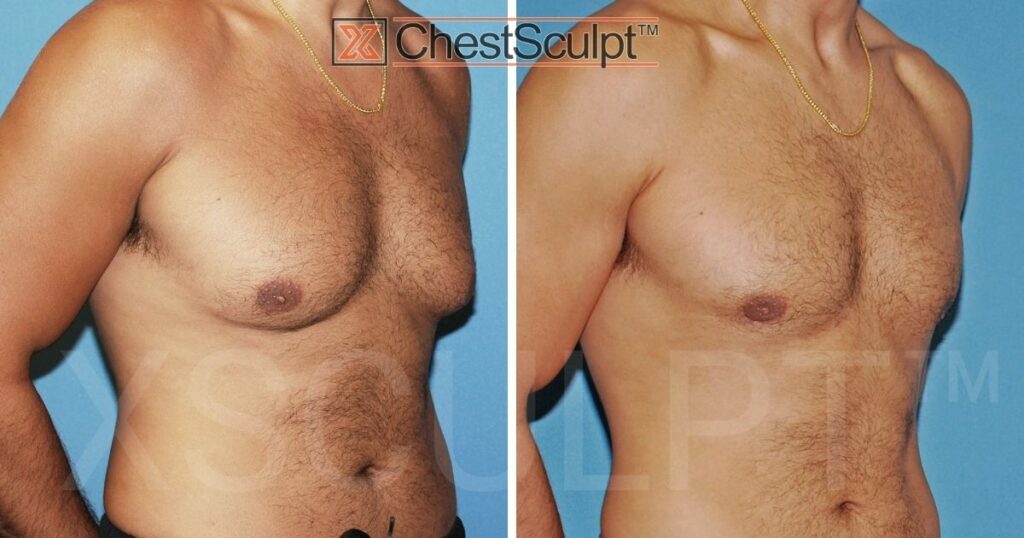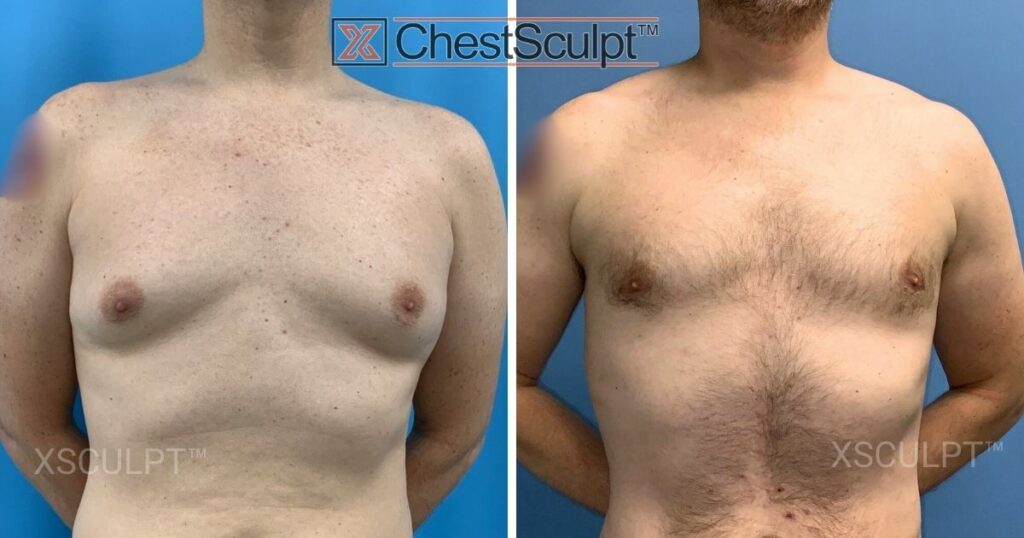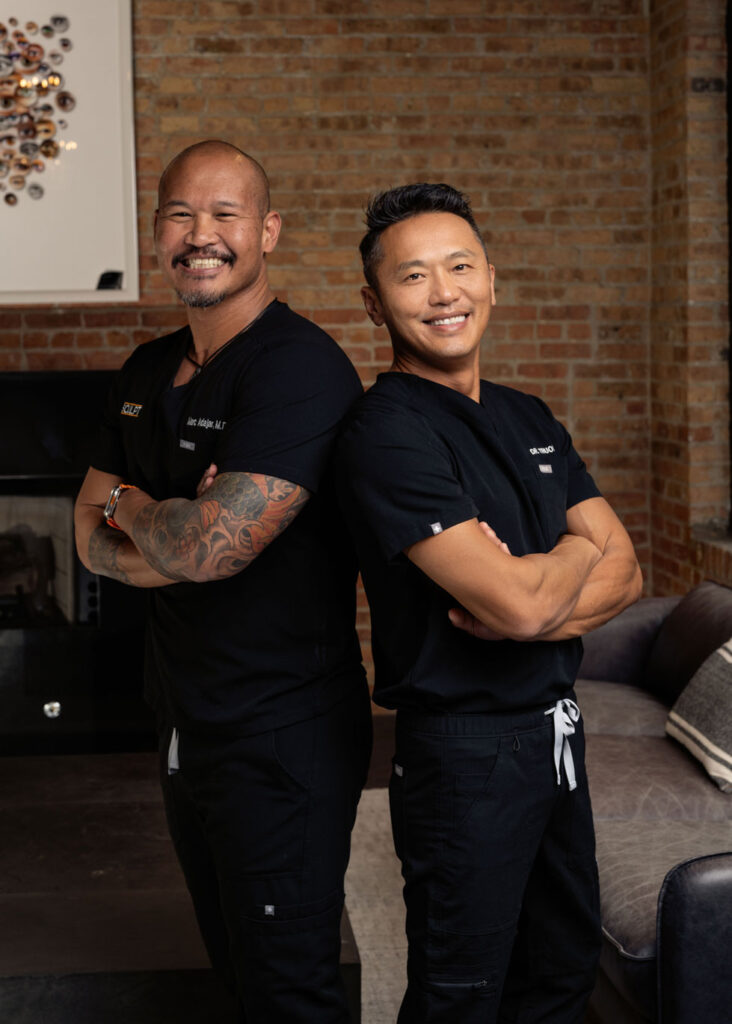Your Guide to Gynecomastia Surgery Near You
Have you ever felt like your reflection in the mirror isn’t what you’d hoped for? Maybe it’s that stubborn male breast tissue despite countless hours of weight lifting and dieting. That can make you feel isolated. But rest assured, you are not the only one experiencing this.
Gynecomastia – an excess accumulation of breast tissue in men – is a silent struggle many grapple with behind closed doors. The journey towards restoring confidence and regaining control over one’s body image often leads to searching for gynecomastia surgery near you.

Table Of Contents:
- Understanding Gynecomastia and Its Treatment Options
- Preparing for Gynecomastia Surgery
- Detailed Procedure of Gynecomastia Surgery
- Recovery and Aftercare Post Gynecomastia Surgery
- Financing Options and Insurance Coverage for Gynecomastia Surgery
- Risks and Complications Associated with Gynecomastia Surgery
- Expected Results from Gynecomastia Surgery
- Expertise
- FAQs in Relation to Gynecomastia Surgery Near
- Conclusion
Understanding Gynecomastia and Its Treatment Options
Gynecomastia is a condition that causes the male chest area to become enlarged. It’s not just about body image; it can also indicate underlying health conditions.

The Basics of Gynecomastia
Gynecomastia, often called “man boobs,” results from an imbalance between testosterone and estrogen hormones in men. When estrogen levels are high compared to testosterone, men develop enlarged breasts. Weight gain can exacerbate this condition as fat cells produce more estrogen.
A variety of factors contribute to gynecomastia, such as aging, certain medications like anti-androgens used for prostate enlargement treatment or cancer therapy, some heart medicines, antidepressants or antibiotics. (source)
Recognizing the Symptoms of Gynecomastia
The main symptom is swelling in one or both breasts. The chest area may feel tender and firm due to excess glandular breast tissue growth rather than fatty tissue typically seen with weight gain alone.
Exploring Treatment Options for Gynecomastia
If gynecomatstic changes result from medication side effects or serious illnesses like liver disease, kidney failure, tumors, then treating those should resolve the issue. However, lifestyle modifications are first-line interventions, including regular exercise and a healthy diet leading to weight loss, which helps rebalance hormones.
In cases where these measures don’t help, then medical treatments may be needed, such as hormone-blocking drugs commonly used in breast cancer treatment.
But when conservative measures fail to deliver results, surgical intervention such as male breast reduction surgery might be necessary. It involves removing excess fat and glandular tissue to restore a flatter, firmer and more masculine chest contour.
Preparing for Gynecomastia Surgery
If you’re planning to undergo gynecomastia surgery, there are some key steps you can take to make sure the process goes smoothly. These include following your surgeon’s pre-operative instructions and making lifestyle changes that will help optimize your results.
Lifestyle Changes Pre-Surgery
Reaching and maintaining a healthy weight before your surgery is essential. Regular exercise and a balanced diet can contribute significantly towards this goal.
Avoiding certain medications, supplements, or recreational substances may also be necessary as these could potentially affect anesthesia or increase bleeding during the procedure. Your gynecomastia surgeon will provide specific guidance on what needs to be avoided.
The Importance of Medical History Disclosure
For your board-certified plastic surgeon to carry out gynecomastia surgery safely, they need a comprehensive account of your medical past. Be transparent about any health conditions you have had or currently have, even if they seem unrelated – everything from allergies to past surgeries should be disclosed at this stage. Here’s more information on how full disclosure helps ensure optimal male breast reduction surgery outcomes.
Fulfilling Pre-Operative Instructions
Dr. Marc Adajar will give detailed instructions regarding food and drink intake before the operation – typically including fasting requirements until surgery. Adherence is critical not just for comfort but also for safety during anesthesia administration.
More details about preparing for gynecomastia surgery can be found here.
Remember, every surgery has its unique aspects, and your preparation should be personalized to you. Ask questions if you’re unsure about any part of the process – this is a significant step towards improving body image, and it’s important that you feel confident throughout.
Detailed Procedure of Gynecomastia Surgery
Gynecomastia surgery, a type of male breast reduction surgery, aims to create a more masculine chest by removing excess glandular tissue and fat deposits. Here’s how the procedure is typically performed.
Anesthesia Options for Gynecomastia Surgery
Our medical team at Xsculpt will ensure you’re comfortable throughout the procedure. This often involves using local anesthesia with sedation or general anesthesia.
Surgical Techniques in Gynecomastia Surgery
For true gynecomastia, surgical excision may be used to remove the glandular breast tissue. For pseudo-gynecomastia, liposuction might remove excess fat from the chest area. The process involves making small incisions through which a thin cannula is inserted to suction out fat cells.
If true gynecomastia exists with enlargement due to glandular growth rather than just fatty tissues, excision techniques are required. Dr. Adajar will remove unwanted tissue via strategically placed incisions for minimal visible scarring. To learn more about our ChestSculpt procedure see here.
In most of our gynecomastia cases, a combination of both procedures is performed to address both types of tissues are present in significant amounts. So, it would help to choose a skilled professional to decide upon the best-suited technique for your case.
Recovery and Aftercare Post Gynecomastia Surgery
Post gynecomastia surgery, your body needs time to heal. This is when the recovery process starts. You must follow post-operative instructions from your surgeon for a smooth recovery.
The initial healing period typically lasts 5-6 days, during which you may experience mild discomfort or pain. But don’t worry; this can be managed effectively with prescribed pain medication.
You must wear an elastic pressure garment over the chest area for about three weeks after surgery. This helps reduce swelling and supports new breast contours as they settle into place. Research shows that following these steps ensures patients get back on their feet quickly while reducing the risks of complications.
Maintaining Your New Masculine Shape
Approximately one month after surgery, most guys are ready to return to rigorous activities such as weightlifting or jogging. A key part of maintaining your newly sculpted physique involves regular exercise and healthy diet habits – even more so if weight gain was one cause of gynecomastia in the first place.
This doesn’t mean crash diets or excessive workouts – just balanced meals and reasonable fitness routines are enough. “A strong body supports better health”, as my gym trainer says. Besides physical activity, choosing clothing styles that suit your new masculine appearance can also considerably boost confidence.
Frequent Follow-ups Are Essential
Regular check-ins allow them to monitor your progress during the recovery phase.
Financing Options and Insurance Coverage for Gynecomastia Surgery
Gynecomastia surgery cost can be a significant factor in your decision-making process. However, there are ways to manage it.
The cost of gynecomastia surgery can vary drastically, contingent upon the surgeon’s aptitude, geographic area, and intricacy of the process. Some may find that their insurance covers all of this treatment if deemed medically necessary.
Review your policy details carefully to understand if you’re eligible for insurance coverage for gynecomastia surgery. Look for terms related to “cosmetic” versus “medically necessary” procedures. If you’re unsure about any points or need help interpreting your plan benefits, ask your insurer directly.
If insurance doesn’t cover your procedure or only provides partial coverage, don’t fret. Several financing options are available, such as medical credit cards and payment plans offered by some clinics or hospitals.
Medical Credit Card Financing
Medical credit cards offer special financing with interest-free promotional periods, which can make paying off surgical costs more manageable over time. To see what financing options Xsculpt offers, see here.
While these strategies can help offset immediate financial pressure from gynecomastia surgery costs, remember to always consider long-term impacts before making decisions based on finances alone.
Risks and Complications Associated with Gynecomastia Surgery
Like any surgical procedure, gynecomastia surgery carries certain risks. Though rare, complications can occur.
Potential Risks of Gynecomastia Surgery
Common potential risks include infection, bleeding, or hematoma formation. Some men may also experience a reaction to the anesthesia used during the procedure.
In other cases, irregularities in contour and asymmetry might be observed post-surgery. These are usually due to variations in healing or changes caused by significant weight gain or loss after surgery.
Complications Post-Surgery
Seromas – fluid collections that develop under your skin – could potentially form following gynecomastia surgery. If this happens, additional treatments like aspiration or drainage may be needed.
Numbness in the chest area is another complication some patients face post-surgery; however, it’s typically temporary and subsides over time as nerves regenerate.
Tips to Minimize Risks & Complications
- Maintaining good health before your operation is crucial for a successful outcome and reduced risk of complications. This includes regular exercise and adhering to a healthy diet prior to surgery.
- Selecting an experienced board-certified plastic surgeon plays a key role, too because expertise significantly lowers surgical risk.
- You should provide an accurate medical history so surgeons can make informed decisions about your care plan.
Understanding these risks doesn’t mean you need to fear going ahead with male breast reduction if you’re grappling with enlarged breasts (a condition called gynecomastia). Rather, it helps inform you better so that, together with your surgeon, you can make a plan that best suits your needs and expectations.
Discussing all potential risks and complications with your plastic surgeon during the consultation phase is important. You should feel comfortable asking any questions, especially concerning the procedure or recovery after gynecomastia surgery.
Minimizing Complications: Keep healthy with regular exercise and a balanced diet before your procedure. It’s also important to choose an experienced professional for the job. This approach can greatly reduce potential complications, making your recovery smoother and quicker.
Expected Results from Gynecomastia Surgery
Gynecomastia surgery is a transformative procedure designed to restore the masculine shape of your chest. Let’s discuss what you can expect post-surgery.
Timeline for Visible Results Post-Surgery
The journey to a more masculine appearance starts with removing excess breast tissue and fat deposits during gynecomastia surgery. But when will you see these results? Typically, initial changes are noticeable immediately after the swelling subsides within 1-2 weeks following the procedure.
You’ll continue seeing improvements as healing progresses. According to Research 1, most patients experience optimal results three months post-op, once residual swelling has fully resolved and tissues have settled into their new contour.
Maintaining Long-Term Results
Your newly sculpted chest area needs care to maintain its look long-term. The good news is that gynecomastia treatment permanently removes glandular breast tissue; this doesn’t regrow. However, weight gain or certain medical conditions could lead to an enlarged breasts look because they might stimulate further growth in remaining fatty tissues around your chest region.
Keeping up your improved body image over time requires some commitment, too: regular exercise helps retain muscle tone while keeping fat accumulation at bay. A healthy diet also plays a significant role here – lean proteins and plenty of veggies.
Remember – it’s not just about aesthetics; getting rid of unwanted male breasts contributes significantly towards better health and well-being overall.
Expertise
Gynecomastia surgery requires the hands of a highly skilled and experienced plastic surgeon. But, how do you identify such expertise? When searching for a qualified surgeon, it is important to consider certain elements.
Certifications and Training
A board-certified plastic surgeon signifies that they have undergone rigorous training in their field. Such certifications reflect a dedication to excellence in patient care and safety.
For instance, Dr. Truong and Dr. Adajar are both accomplished cosmetic surgeons and board-certified, meaning he has met stringent requirements regarding their education, examination results, surgical experience, ethical conduct, etc., established by the American Board of Cosmetic Surgery.
Surgical Skills and Experience
The ability to remove excess breast tissue or fat deposits while sculpting a more masculine chest shape demands precision skills honed over years of performing gynecomastia surgeries. You’ll want someone who knows their way around glandular breast tissue and excess skin.
Patient Testimonials
Nothing speaks louder about a surgeon’s abilities than happy patients. Reading testimonials gives insight into previous patients’ experiences with gynecomastia surgery.
Gynecomastia Surgery Before and After Photos
Before and after photos can help with seeing the types of results you can expect to achieve when undergoing ChestSculpt gynecomastia surgery.
FAQs About Gynecomastia Surgery Near Me
How much is gyno surgery in Chicago?
Gynecomastia surgery costs vary, but you might pay between $6,000 and $10,000 or more depending on your individual case. Remember, location and surgeon’s experience can affect the price. For more on how much gynecomastia surgery costs read here.
Will insurance cover gynecomastia?
Often a gynecomastia procedure is not covered because insurers see it as a cosmetic and elective procedure. We recommend checking with your individual insurance provider. However it’s important to note we do not accept insurance payments and you will be responsible for submitting any claims for possible reimbursement.
Conclusion
- Gynecomastia surgery near you can be the ticket to reclaiming your confidence. It’s not just about removing excess breast tissue—it’s about shaping a more masculine appearance.
- Preparing for this transformative journey means understanding gynecomastia, recognizing its symptoms, and exploring various treatment options. Remember that lifestyle changes and pre-operative instructions are key to optimizing results.
- The process involves anesthesia choices, surgical techniques, and potential risks—but with the right cosmetic surgeon at your side, these hurdles can be easily navigated. And once it’s done? Your recovery period becomes a path toward regaining normalcy in life.

GET YOUR COMPLIMENTARY ANALYSIS AND CONSULTATION TODAY
XSCULPT was founded by two award-winning board-certified surgeons Dr. Marc Adajar & Dr. Anh-Tuan Truong. Our practice specializes in body contouring procedures, including Gynecomastia (Male Breast Reduction), Abdominal Etching, Lipo 360, Vaser Hi Definition Liposuction, Male Puffy Nipple Reduction, Male Tummy Tuck, and Non-Surgical Fat Reduction. Medical services include Hormone & Testosterone Replacement Therapy, Anti-Aging, Peptide Therapy and Medical Weight Loss.
